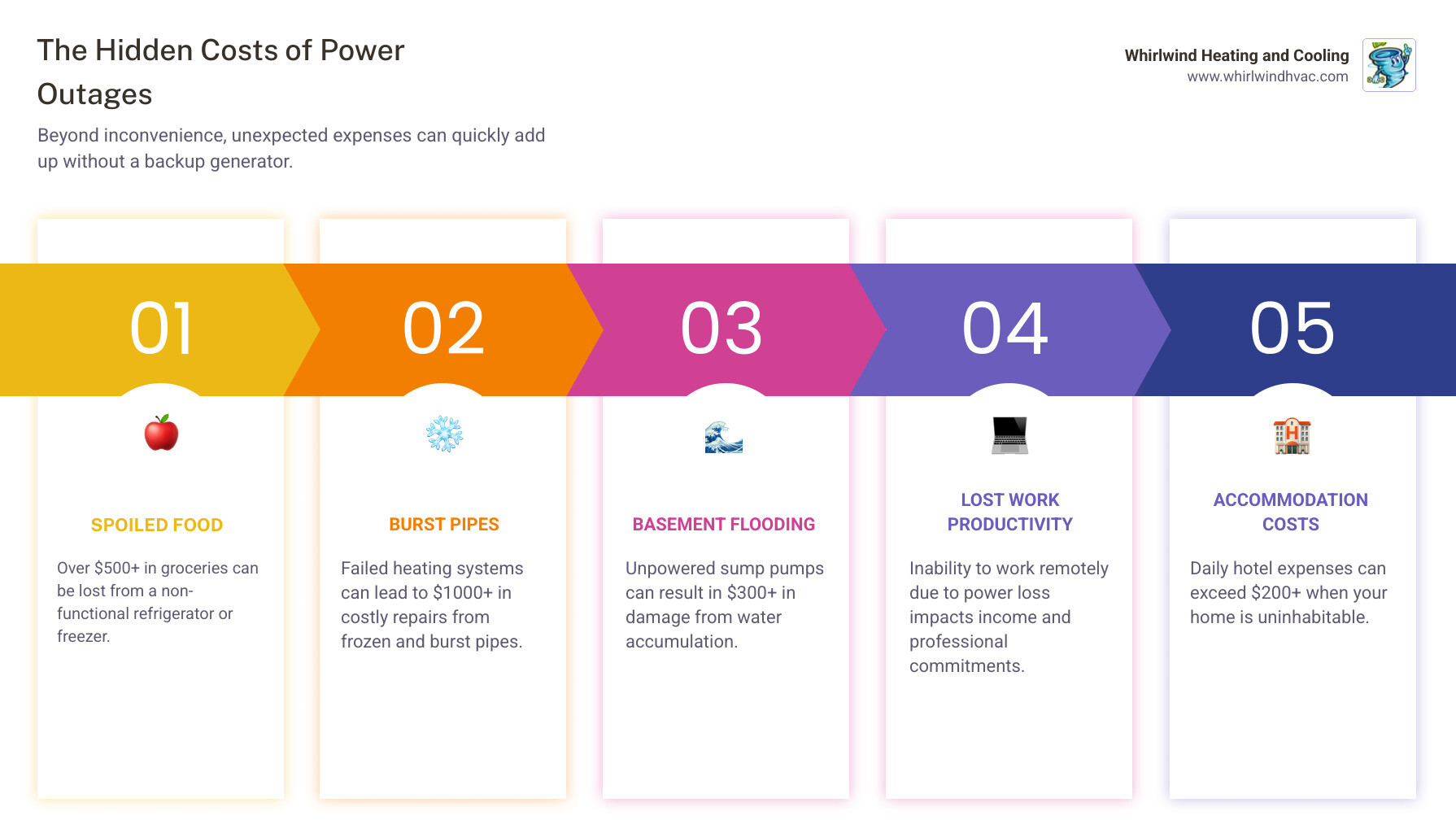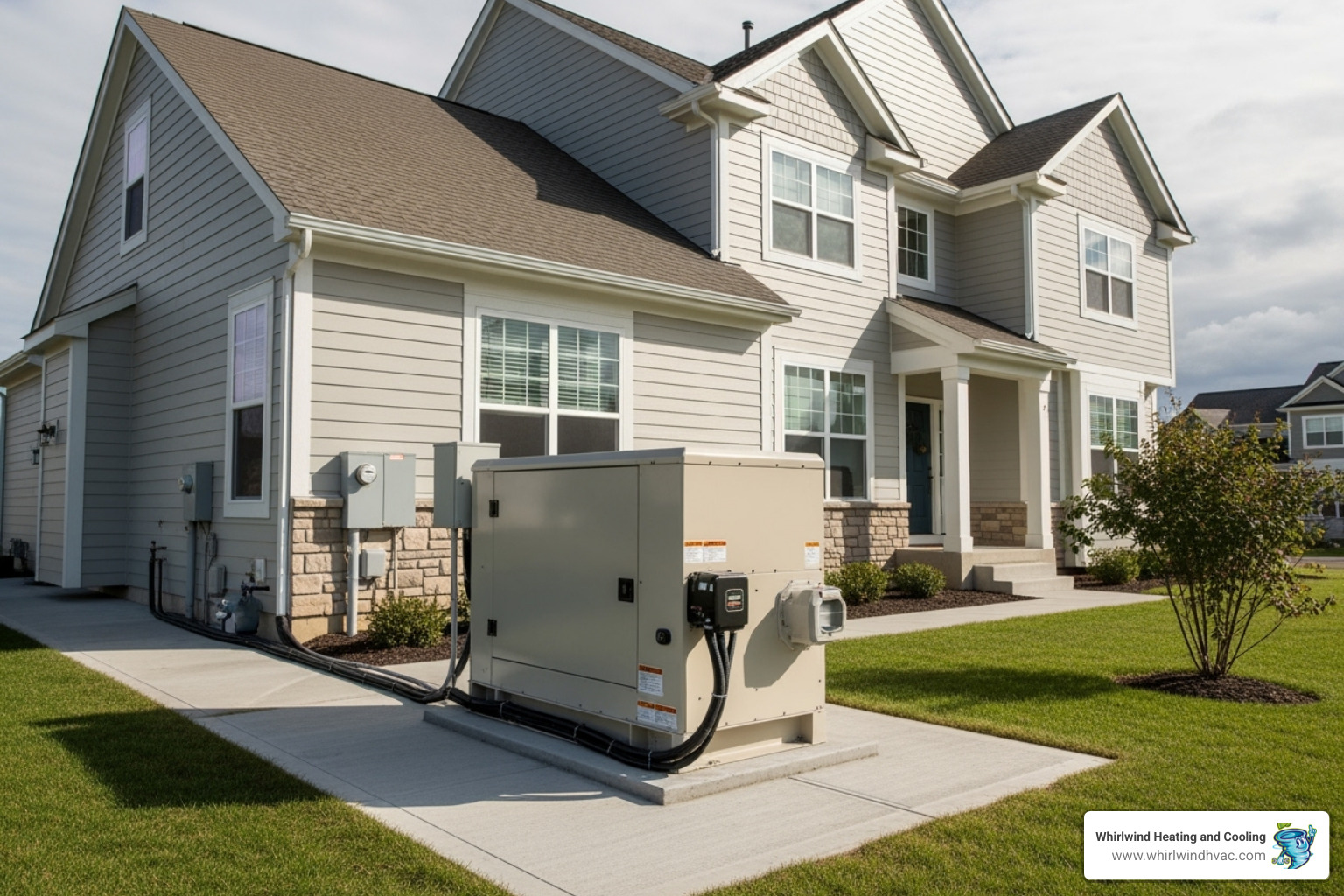Why Backup Power is a Modern Necessity
An emergency generator is a backup power system that provides electricity during power outages, protecting your family and property from the costly consequences of losing power.
Key Emergency Generator Essentials:
- Purpose: Provides backup electricity during utility power failures
- Types: Portable (manual setup) or standby (automatic whole-house)
- Fuel Options: Natural gas, propane, diesel, or gasoline
- Power Range: 5kW to 150kW+ depending on home size and needs
- Connection: Links to home electrical system via transfer switch
- Cost: Starting around $4,000 for whole-house units (plus installation)
During a recent storm, one family’s standby generator kept their home running normally. While neighbors faced spoiled food and cold homes, they had lights, refrigeration, and comfort, proving the generator’s value.
The hidden costs of power outages go far beyond inconvenience. A single blackout can cause thousands of dollars in losses from spoiled food, burst pipes, basement flooding, and lost work productivity.
In Oregon’s unpredictable weather, generators have become essential home systems. Modern emergency generators offer quiet operation (65dB or lower), automatic startup, and smart monitoring through mobile apps. The cost of a quality system often pays for itself after just one major outage by preventing property damage, avoiding hotel costs, and preserving food supplies.
Understanding the Basics: How an Emergency Generator Works
An emergency generator is your home’s insurance policy against power outages. It keeps the power flowing when the main electrical grid fails by combining an engine with an alternator to create electricity on demand. The engine, running on natural gas, propane, diesel, or gasoline, spins the alternator to convert mechanical energy into electrical power.
What makes modern standby generators so effective is their intelligence. They work with an Automatic Transfer Switch (ATS) to monitor your home’s power 24/7. When they detect an interruption, they automatically start and restore power within seconds, often before you even notice the outage. These are not the temperamental portable units used for camping; standby generators are built for one job: starting reliably every time.
For more insight into how generators work alongside other modern home systems, check out our guide on modern home systems.
How does it connect to a house?
The connection between your emergency generator and your home is managed by an Automatic Transfer Switch (ATS). This device sits between your main electrical panel and the utility connection, constantly monitoring grid power.
When the ATS senses a power loss, it performs two critical functions:
- It disconnects your home from the utility grid. This crucial safety feature, known as anti-islanding, prevents your generator from sending electricity back into the power lines, which could injure utility workers.
- It signals your generator to start. Once the generator reaches full power (typically in 10-20 seconds), the ATS switches your home’s electrical load from the dead utility lines to your generator.
When utility power returns, the process reverses automatically. The ATS switches your home back to grid power and signals the generator to shut down after a brief cool-down period.
This system differs from an Uninterruptible Power Supply (UPS), which provides instantaneous but short-term power for electronics. An emergency generator has a brief 10-20 second interruption but can run for days or weeks. Professional installation by a team like Whirlwind Heating and Cooling is required to ensure the system is connected safely and to code.
Choosing Your Power Source: Types of Emergency Generators
Choosing the right emergency generator is simpler once you understand the two main types: portable and standby.
| Feature | Portable Generator | Standby (Whole-House) Generator |
|---|---|---|
| Fuel Types | Gasoline, Diesel, Propane, Dual-Fuel | Natural Gas, Propane, Diesel |
| Power Output | Lower (1,000W – 15,000W) | Higher (8,000W – 150,000W+) |
| Cost | Lower initial purchase ($500 – $2,500) | Higher initial purchase ($4,000 – $20,000+ for unit alone) |
| Installation | Manual setup, plug-and-play | Permanent, professional installation, automatic transfer switch |
| Operation | Manual start, manual refueling | Automatic start and stop, automatic fuel supply |
| Noise Level | Generally louder | Quieter (many modern units operate at 65dB or lower) |
| Best Use Cases | Camping, job sites, temporary power for essential items during short outages | Whole-home backup, long-term outages, critical infrastructure, peace of mind |
Standby vs. Portable Generators
Portable generators are versatile units you can move where needed. They are ideal for powering a few essential appliances during shorter outages, camping, or on job sites. They require manual starting, refueling, and must be operated outdoors due to carbon monoxide risks.
Whole-house standby generators are permanent installations that offer the ultimate peace of mind. Connected directly to your home’s electrical system and fuel supply (natural gas or propane), they operate automatically. They sense a power outage and turn on without you lifting a finger, capable of powering your entire home, including HVAC systems and sump pumps.
Fuel Types: From Fossil Fuels to Future Tech
The right fuel depends on availability, storage, and cost.
- Gasoline: Widely available and powers most portable units. However, it has a short shelf life and requires stabilizers for storage.
- Natural Gas: The gold standard for standby generators if your home has a gas line. It provides a virtually unlimited, clean-burning fuel supply, ideal for long outages.
- Propane: A great alternative to natural gas, especially in areas without gas lines. It’s stored in tanks on your property and has an excellent shelf life.
- Diesel: Powers heavy-duty, fuel-efficient generators built for long-term use. The upfront cost is higher, but it’s a reliable choice for serious backup power.
Newer inverter generators and battery power systems offer quieter, more efficient, and emission-free options. Inverters are great for sensitive electronics, while batteries are best for shorter-term needs.
For homeowners ready to explore their options, learning how to pick the right Generator helps ensure you make the best choice for your specific needs and budget.
Sizing and Installation: Your Guide to a Perfect Fit
Choosing the right size emergency generator is crucial. A generator that’s too small won’t power your essentials, while one that’s too large wastes money on purchase price and fuel.
How to Choose the Right Size Emergency Generator
To size your generator, first identify the essential systems you need during an outage. This typically includes your HVAC system, refrigerator/freezer, and critical items like sump pumps, well pumps, or medical devices.
Every appliance has two power ratings: running watts (continuous use) and starting watts (the initial surge). For example, a refrigerator might use 800 running watts but need 2,000 starting watts. A central AC unit is a major power draw, potentially needing 15,000 starting watts.
A professional load calculation adds up the running watts of all your essentials and accounts for the highest starting wattage. Always add a 20-30% buffer to this total. This ensures the generator doesn’t run at maximum capacity, extending its life and providing flexibility.
For reference, manufacturer pricing for whole-house units starts around $3,957 for a 13kW model and $5,438 for a 20kW model. This does not include the transfer switch or installation.
Key Considerations for Professional Installation
Professional installation is not a DIY project; it’s essential for safety, reliability, and code compliance. Key steps include:
- Foundation: The generator must sit on a solid, level concrete pad to prevent mechanical issues.
- Location: Proper placement requires specific clearances from windows, doors, and combustible materials to meet safety codes. Modern units are quiet (65dB or lower), but placement still matters.
- Fuel Connection: Whether connecting to a natural gas line or a propane tank, fuel lines must be installed by a professional to prevent dangerous leaks.
- Electrical Work: A licensed electrician must install the Automatic Transfer Switch (ATS). This complex device safely disconnects your home from the grid and switches power to the generator.
- Permits and Inspections: Professionals handle all necessary permits and inspections to ensure your installation meets local safety and building codes.
Our team at Whirlwind Heating and Cooling manages the entire process, ensuring your generator is installed correctly. For comprehensive generator installation and other HVAC Services in Woodburn OR, our experienced team ensures everything is done right the first time.
Safety, Regulations, and Maintenance
An emergency generator is a powerful piece of equipment that requires proper care and respect to operate safely.
Critical Safety Precautions
- Carbon Monoxide (CO) Poisoning: This is the most serious risk. Never run a generator in a garage, basement, or any enclosed space. Portable units must be outdoors, far from windows and doors. Many new generators have CO detection systems, and you should also have CO detectors in your home.
- Grounding: Proper grounding is required to prevent electrical shock. Professional installation ensures this is done to code.
- Refueling: Always shut down the generator and let it cool completely before refueling to prevent fires. Store fuel in approved containers away from heat sources.
Codes and Compliance for Your Emergency Generator
Installing a generator involves navigating safety codes and regulations that protect you, your neighbors, and utility workers.
- Clearance and Fire Safety: Codes mandate specific clearances around the generator for ventilation and fire safety, often at least one meter. Fire-resistant barriers may be required depending on placement.
- Permits: Local permits are required to ensure your installation meets all building, electrical, and zoning codes. Projects like the Emergency Generator Project – Salem Housing Authority show the importance of proper compliance.
- Wiring: Electrical wiring must be protected from fire to ensure the generator functions during an emergency, following national and local electrical codes.
Routine Maintenance for Lasting Reliability
Regular maintenance ensures your emergency generator starts reliably when you need it most.
- Self-Tests: Most standby generators run automatic weekly or bi-weekly self-tests to verify they are ready.
- Fluid and Filter Changes: Like a car, generators need annual oil and filter changes. Air filters and spark plugs also require periodic replacement.
- Fuel System: Ensure propane tanks are full, natural gas lines are clear, and diesel fuel is treated with a stabilizer.
- Battery: The starting battery must be inspected regularly for corrosion and proper charge to ensure the generator can start automatically.
Professional servicing is the best way to catch problems early and extend your generator’s life. Our maintenance plans cover all these points, helping you realize the full standby generators advantages and protecting your investment.
The Economics of Emergency Power: Costs and Considerations
An emergency generator is a significant financial decision. Understanding the full scope of costs helps homeowners make the best choice for their budget.
Initial Purchase and Installation Costs
The total investment for a professionally installed system typically ranges from $8,000 to $25,000+. This includes several components:
- Generator Unit: This is the largest single expense. For example, a 13kW unit from a quality manufacturer like Cummins has an MSRP of around $3,957, while a 20kW unit is about $5,438 MSRP.
- Automatic Transfer Switch (ATS): This essential component adds to the cost but is critical for seamless, automatic operation.
- Professional Installation: Labor for certified electricians and plumbers to handle complex electrical and gas line connections is a significant part of the cost but ensures safety and reliability.
- Site Preparation: Costs for a concrete pad, drainage, and creating proper clearances can add several hundred to over a thousand dollars.
- Permits and Inspections: These mandatory fees vary by location but guarantee your installation meets safety standards.
Ready to get specific numbers for your home? You can easily request an estimate from our team.
Ongoing Expenses and Fuel Consumption
Beyond the initial purchase, plan for these ongoing costs:
- Fuel Costs: This varies by fuel type. Natural gas is often the most convenient and cost-effective. Propane requires a storage tank and periodic refills. Gasoline and diesel for portable units have the highest per-hour operating costs.
- Maintenance Plans: Annual service plans, typically a few hundred dollars, cover routine checks, fluid changes, and diagnostics. This is far less than the cost of a major repair or a system failure during an outage.
- Warranty Coverage: Quality manufacturers offer long-term warranties (e.g., 10 years), but they require documented professional maintenance.
- Repairs: While proper maintenance minimizes them, unexpected repairs for parts like batteries or control boards can occur over the generator’s lifespan.
The return on investment for an emergency generator is clear when you consider the avoided costs of spoiled food, hotel stays, and property damage like frozen pipes. Most homeowners find their generator pays for itself after just one major outage, delivering priceless peace of mind.
Conclusion: Securing Your Home’s Power and Peace of Mind
When the lights go out in your neighborhood, there’s something deeply comforting about knowing your family will stay safe, warm, and connected. That’s the real value of an emergency generator – it’s not just about keeping the electricity flowing, it’s about protecting what matters most to you.
Throughout this guide, we’ve walked through everything you need to know about emergency generators. From understanding how these remarkable machines work to choosing between standby and portable options, we’ve covered the technical details that help you make smart decisions. We’ve explored the importance of proper sizing and professional installation, discussed critical safety measures and maintenance requirements, and broken down the real costs involved.
The bottom line is simple: an emergency generator delivers reliability when you need it most. It keeps your food fresh during extended outages, prevents costly pipe damage when heating systems fail, and ensures your family stays comfortable regardless of what Oregon’s unpredictable weather throws your way. The peace of mind alone is worth the investment.
Every home’s power needs are different. Your perfect emergency generator depends on what you want to keep running, your fuel preferences, your budget, and how much automation you desire. Maybe you need a whole-house standby unit that kicks in automatically, or perhaps a portable generator for essential items makes more sense for your situation.
This is where our team at Whirlwind Heating and Cooling makes the difference. We’ve been serving families throughout the Willamette Valley for years, and we understand the unique challenges our region faces. Our approach is straightforward – we listen to your needs, recommend the right solution, and install it correctly the first time. Our mission is simple: “Do it right, at a fair price.”
We handle every aspect of your emergency generator project, from helping you choose the perfect system to professional installation and ongoing maintenance. We know the local codes, we work with the best manufacturers, and we stand behind our work with responsive service when you need it.
Don’t wait for the next storm to wish you had backup power. The best time to install an emergency generator is before you need it. Whether you’re in Woodburn, Salem, Portland, Silverton, or anywhere else in the Willamette Valley, we’re here to help you take control of your home’s energy security.
Ready to explore your options? Visit our Generators Woodburn OR page to learn more about how we can keep your lights on and your family comfortable, no matter what tomorrow’s weather forecast brings.





